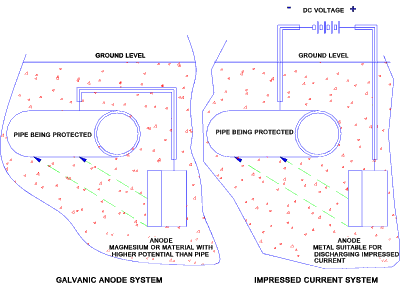Corrosion of Piping Notes...
|
Introduction A significant proportion of the corrosion problems experienced relate to piping systems. Piping systems are used to transfer a wide range of fluids in a wide range of environments. A major lifetime costs for any industrialised plant is the cost of leaking fluids and the cost of repair of piping system to prevent and eliminate leaks. The main methods of preventing corrosion in piping systems are as follows;
Piping Materials
There is an extremely wide range of pipeline
materials available . These are selected
on various criteria the two most important of which
are suitability for service and cost. The
suitability for service is determined primarily on
the materials resistance to attack by the fluid being
transferred and the external environment.
The internal corrosion resistance is more important
than the external resistance. It is easier to protect
and monitor and repair the external surfaces.
Also the environment generally provides a
less arduous regime.
Pipeline Material Notes
Carbon Steel Stainless Steel Steels specifically alloyed for corrosion resistance generally with chromium levels above 18%. Steels resist oxidisation and specific corrosion of virtually all chemicals over a wide temperature range (-200oC to 900oC ). The corrosion resistance is related to the grade selected. Stainless steels are represented in all design codes and are convenient to use. Stainless steel generally costs a least 4 times more than carbon steels. Cast Iron /Ductile IronTwo types of cast iron are used, grey cast iron and ductile iron. The former includes graphite as flakes and the latter includes graphite in spherical or nodular form. Cast iron piping has been widely used over the years for transferring a wide range of fluids as it is a low cost option with excellent corrosion resistance to a wide range of environments and fluids. The grey cast irons are generally being superseded by the ductile iron options and the ductile iron piping systems are now being generally replaced by plastic piping. The British Standard for Ductile piping and fittings is BS 4772. Lead Lead has been used in the past for a wide variety of domestic, civil and chemical piping. It is suitable for most chemicals it is readily available and easily worked. Although lead is expensive it is can be totally recovered and reused. Lead has low strength properties and suffers from creep. It can be alloyed to improve the strength and creep resistance. Lead is no longer used for domestic piping for human health reasons. Lead not widely used now because plastic piping provides improved properties at lower costs. Copper, Brass, Copper Nickel AlloysPiping and tubing made from these metals are used for many purposes throughout industry and also for building and domestic use and for ship pipework engineering because of the resistance of the brasses to sea water attack. Copper and the associated metals generally conform to the relevant standards and are therefore conveniently produced and installed.
Aluminium piping is supplied in two grades to BS 1471: 1972 . Aluminium is used in many industries and provides excellent corrosion resistance compared to steel for arduous fluid flow applications. Glass and Glass Lined pipingGlass piping and glass lined piping provides ideal corrosion resistance to most fluids. However this material is not coveniently installed and has various mechanical limitations. It is used mainly for specialised application including laboratories. TitaniumThis material has only recently been available in quantity. At this time it is relatively expensive compared to most other materials. However if lifetime costing is consided it would likely be competitive as it has superb corrosion resistance especially for seawater transfer duties. When installed in seawater systems titanium piping provides long continuous service compared to virtually all other metals. Elastomer/Plastic Lined Steel PipingThis option provides a relatively low cost method of producing a highly corrosion resistant piping system with good mechanical properties. However if system design, manufacture and installation is not good the lining system may fail resulting in high rates of local corrosion and expensive early repairs. Plastic Piping SystemsPiping systems made from plastics including HDPE, ABS, PVC etc. are not subject to the same corrosion problems experienced by metal piping systems. More and more piping systems are being manufactured from plastics However plastics have severely limited mechanical mechanical and thermal properties and are attacked by some chemicals. Surface Coating Options This area of design is discussed on separate page Surface coatings Location/Geometry of piping systems The life of a piping system can be significantly improved if the system is correctly designed in respect to geometry and location. The piping should be designed to ensure that there are no low points which are not fully drained. The piping should also be located to minimise the risk of attack from the environment. If possible piping should be protected against environments which include excessive precipitation in industrial or marine areas. Cathodic Protection
Galvanic anode system 
Cathodic protection systems require specialised design involvement. |
Links to Corrosion of Piping
|
|